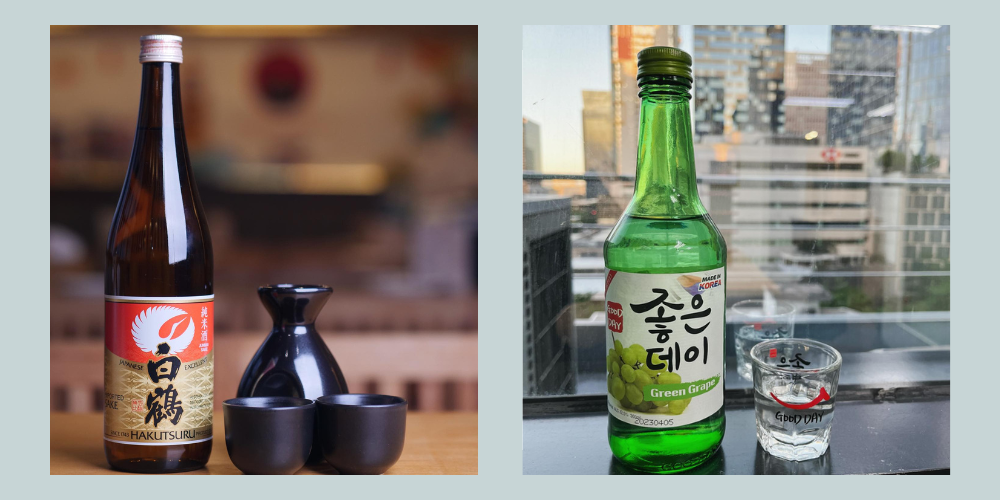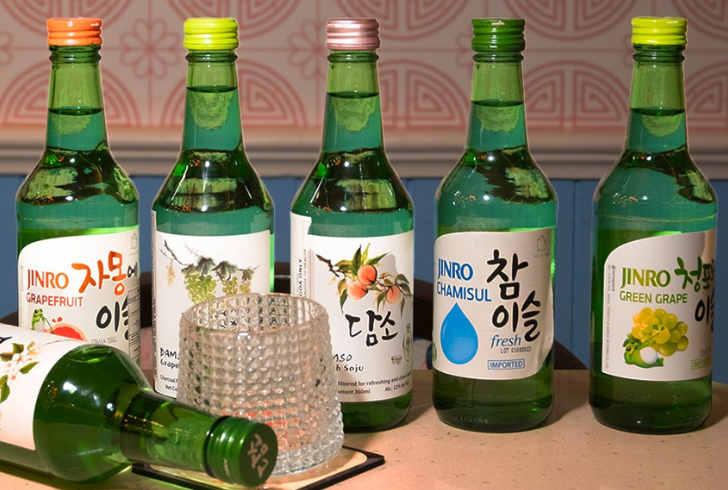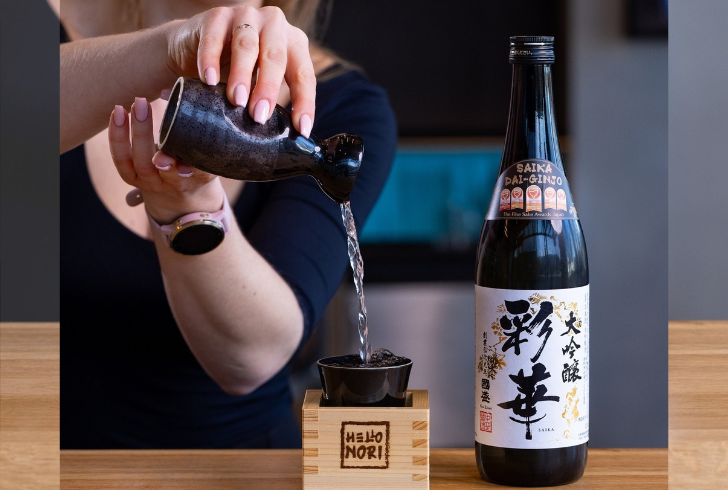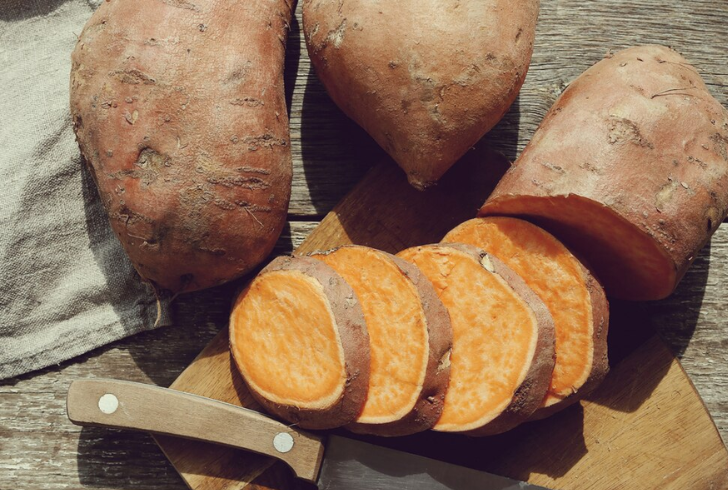
What is Soju vs Sake and How Do They Differ?

If you’ve delved into the world of Asian cuisine, chances are you’ve encountered the names ‘soju’ and ‘sake’. These two beverages, deeply ingrained in the cultural fabric of South Korea and Japan respectively, carry with them a rich history and a myriad of flavors. But what exactly are these intriguing drinks, and how do they differ?
Understanding What is Soju vs Sake
Soju – The Korean Kick

Instagram | korea.goa | Originating from South Korea, soju is a transparent distilled liquor traditionally made from rice.
Soju, hailing from South Korea, is a clear, distilled spirit traditionally crafted from rice. However, modern variations incorporate other starches like wheat, barley, and even sweet potato. This versatility allows soju to boast a range of alcohol content, typically between 16.8% and a whopping 53% ABV – packing a punch compared to sake! The neutral taste, often likened to vodka, makes it a clean and refreshing choice.
However, unlike vodka’s harsh bite, soju offers a subtle sweetness, making it surprisingly smooth. For those seeking a touch of adventure, flavored soju varieties abound, exploding with fruity notes like apple, peach, and citrus, or even venturing into unexpected territories like yogurt or pomegranate. Soju’s adaptability makes it a perfect companion to Korean cuisine, particularly spicy dishes. A shot of soju in between bites acts as a palate cleanser, ensuring you fully appreciate the complex flavors of your meal.
Sake – The Soul of Japan
Sake, on the other hand, transcends the realm of spirits and enters the world of rice wines. While often referred to as “rice wine,” sake’s brewing process actually shares more similarities with beer than wine. Polished rice undergoes a meticulous fermentation process involving koji mold, a unique ingredient that unlocks the starches and transforms them into sugars.
This delicate dance results in a beverage with an alcohol content averaging around 16%, significantly lower than soju. Sake boasts a light and refreshing flavor profile, often described as dry and slightly sweet, with subtle hints of umami – a savory richness. Depending on the brewing technique, some sakes may lean towards a drier or sweeter profile, offering a spectrum of taste experiences.
What is Soju vs Sake Etiquette?

Instagram | hellonori | Sake, rich in tradition, is frequently presented in a petite ceremonial vessel.
While both soju and sake are traditionally served chilled in small glasses, the etiquette surrounding their consumption differs slightly. Soju is typically enjoyed neat, allowing its clean and crisp flavor to shine through. In Korea, soju is a cherished companion to meals, particularly those featuring bold and spicy flavors. The neutral taste of soju acts as a palate cleanser, ensuring you fully appreciate the nuances of your culinary adventure.
Sake, steeped in tradition, is often served in a small ceremonial cup. Despite its size, sake is not meant to be downed in a single shot. Instead, it’s savored sip by sip, much like you would enjoy a glass of fine wine or tea. Sake can be enjoyed hot or cold, depending on your preference. It pairs beautifully with appetizers, light sushi dishes, and is a popular beverage at lively izakaya bars. Sparkling sake, a unique variation served chilled, offers a celebratory touch, akin to champagne.
Soju vs Sake – A Tale of Two Delights

Freepik | Racool_studio | Soju traditionally uses rice, but modern versions incorporate wheat, barley, and even sweet potato.
While soju and sake might play similar roles in Korean and Japanese cultures, their underlying characteristics paint a picture of distinct identities. Here’s a quick breakdown to illuminate the key differences:
- Production Method: Soju is a distilled spirit, whereas sake is a brewed beverage.
- Alcohol Content: Soju packs a stronger punch, ranging from 16.8% to 53% ABV, compared to sake’s average of 16%.
- Ingredients: Soju traditionally uses rice, but modern versions incorporate wheat, barley, and even sweet potato. Sake stays true to its roots, crafted exclusively from rice.
- Aroma: Soju has a neutral yet strong alcoholic scent, similar to vodka. Sake, in contrast, exudes a mild and sweet fragrance with hints of rice and fruit.
- Flavor Profile: Soju boasts a neutral base with flavored variations offering a wide range of options. Sake presents a more limited flavor spectrum, typically described as creamy, refreshing, and light, with drier or sweeter variations depending on the brewing process.
Choosing Your Perfect Sip
So, which beverage emerges victorious in the soju vs sake showdown? The truth is, there’s no single champion! The ideal choice hinges on your personal preferences. If you crave a clean, strong spirit with a hint of sweetness, soju might be your perfect match.
For those seeking a nuanced, rice-based beverage with a lower alcohol content, sake could be your love story waiting to unfold. Ultimately, the best way to decide is to embark on your own taste bud adventure and explore both soju and sake!
More in Luxury & Life Style
-
`
Cowboy Superstitions and Traditions That Might Surprise You
Picture this: the chute clangs open, dust plumes, and all eyes track a cowboy mid-stride. But what the crowd doesn’t see...
July 22, 2025 -
`
What’s Changing for Student Loans After Trump’s New Spending Bill?
The passing of President Donald Trump’s latest spending bill is shaking up more than just tax brackets and business deductions—it’s poised...
July 16, 2025 -
`
Why Big Tech Is Divided on the Future of Artificial General Intelligence
Fifteen years ago, the founders of DeepMind—Sir Demis Hassabis, Mustafa Suleyman, and Shane Legg—set a bold goal: “Build the world’s first...
July 1, 2025 -
`
Planning a Wedding? These Money-Saving Tips Actually Work
Weddings are meant to be memorable, not financially draining. But for many couples, the cost of tying the knot often brings...
June 24, 2025 -
`
Did MrBeast Really Borrow Money From His Mother for His Wedding?
YouTube star Jimmy Donaldson, widely known as MrBeast, sparked surprise when he shared a personal update on X. Despite leading the...
June 17, 2025 -
`
How Smart Technology Is Changing the Way We Travel
Technology has reshaped nearly every part of modern life, and travel is no exception. From how we plan trips to how...
June 12, 2025 -
`
Why Some Tech CEOs Are Replacing Themselves With AI Avatars
In a move that signals a shift in how corporate communication is handled, major tech CEOs are beginning to hand the...
June 3, 2025 -
`
Is Innovation Dead in American Pop Culture?
Has something changed in the way we engage with American pop culture? Scroll through your favorite streaming service, tune into the...
May 27, 2025 -
`
7 Key Steps to Start a Profitable Digital Products Business
Starting a digital products business offers an exciting opportunity to turn your skills and knowledge into a revenue-generating venture. Whether you’re...
May 20, 2025














You must be logged in to post a comment Login